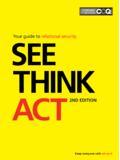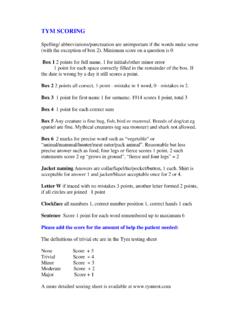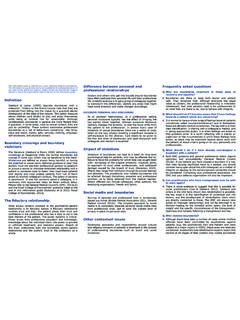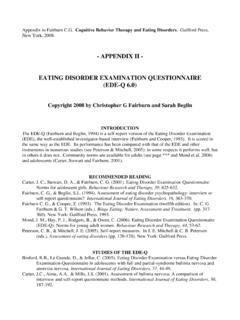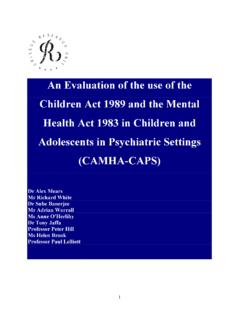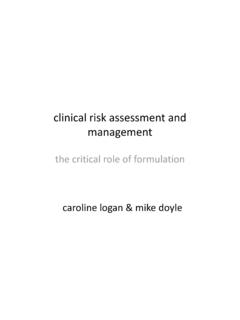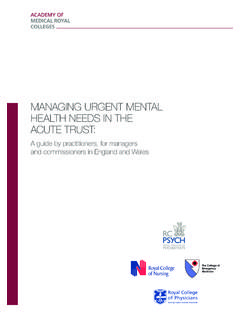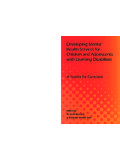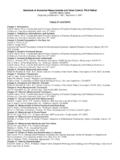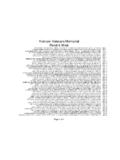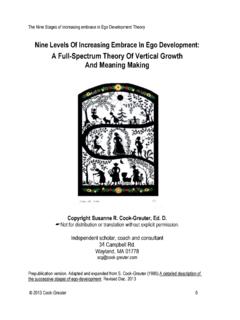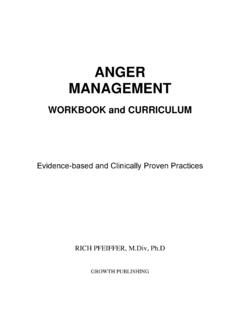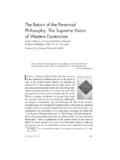Transcription of Psychosis or Spiritual Emergence - Royal College of ...
1 ' Psychosis or Spiritual Emergence ? - Consideration of the Transpersonal Perspective within Psychiatry' Dr. Nicki Crowley * Fool's gold exists because there is real gold Rumi As we progress into the 21st century, psychiatry is broadening its repertoire to further understand the problem of madness. Psychosis as an altered state of consciousness (ASC) Our deepening understanding of brain, mind and consciousness leaves us no option but to expand the neurobiology of Psychosis to incorporate the concept of consciousness; its nature, levels, dimensions and dynamics, and the impact this function plays in the development of challenging, abnormal states of mind.
2 Psychosis has been defined as any one of several altered states of consciousness, transient or persistent, that prevent integration of sensory or extrasensory information into reality models accepted by the broad consensus of society, and that lead to maladaptive behaviour and social Psychotic phenomena such as delusions and hallucinations, described and classified in ICD10 2 and DSM VI 3, follow clinical observations, which in western society are understood as symptoms of illness. This is based on the assumption that we understand the nature of reality , and that there is a narrow band of normal perception, outside of which there is little useful potential.
3 That certain dramatic experiences and unusual states of mind could be more than part of a purely pathological mental state, and hold some potential for personal growth and transformation is the subject of this paper. Spiritual emergency, consciousness and the transpersonal perspective Observation from many disciplines, including clinical and experimental psychiatry, modern consciousness research, experiential psychotherapies, anthropological field studies, parapsychology, thanatology, comparative religions and mythology have contributed to the concept of Spiritual emergency a term that suggests both a crisis and an opportunity of rising to a new level of awareness or Spiritual Emergence .
4 This term was first coined by Stan and Christina Grof who founded the Spiritual Emergency Network at the Esalen Institute in 1980. Its remit was to assist individuals and make referrals to therapists for people experiencing psychological difficulties associated with Spiritual practices and spontaneous Spiritual experiences. Grof describes a Spiritual emergency: There exist spontaneous non-ordinary states of consciousness, (NOSC) that would in the West be seen and treated as Psychosis , and treated mostly by suppressive medication. But if we use the observations from the study of non-ordinary states, and also from other Spiritual traditions, they should really be treated as crises of 1transformation, or crises of Spiritual opening.
5 Something that should really be supported rather than suppressed. If properly understood and properly supported, they are actually conducive to healing and transformation . 4 In order for psychiatry to appreciate the relevance of this perspective to the medical diagnosis and treatment of Psychosis , it is necessary to move beyond our materialistic, biomechanical focus on brain function and start to expand on the concept of consciousness - that fundamental yet intangible core aspect of aliveness , within which is held our perceptual awareness of experience. Medicine, psychiatry and traditional psychotherapies hold the assumption that consciousness is a by-product (or epiphenomenon) of the brain and cannot persist independently of it (the productive theory of consciousness).
6 5 The transmissive theory of consciousness 5 holds that consciousness is inherent in the cosmos and is independent of our physical senses, although is mediated by them in everyday life. So the brain and the psyche can be thought of acting as a lens through which consciousness is experienced in the body. This forms the basis of the transpersonal perspective, which received its initial articulation by thinkers and scholars in the field of psychology, Carl Jung, Robert Assagioli, Ken Wilbur and Stanislav Grof amongst others. They recognised the limitations of the field of psychology and sought insights and teachings from the Spiritual traditions and certain philosophical schools of the east.
7 The term transpersonal is used here to refer to psychological categories that transcend the normal features of ordinary ego-functioning, that is, stages of psychological growth, or consciousness, that move beyond the rational and precede the mystical. At the root of the transpersonal perspective is the idea that there is a deep level of subjectivity or pure spirit that infuses all matter and every event. A common metaphor throughout the Spiritual wisdom traditions refers to this consciousness, or living spirit, (be it called Brahman, Buddha-Mind, Tao, or The Word) as having been breathed into all being at the moment of creation as a manifestation of divine nature.
8 It is necessary for sentient life, because experience and awareness are possible only through the activating power that flows from this Source. Transpersonal theory is a way of organising our experience of reality ; it is not that reality itself. It relies on the phenomenological observations of inner subjective experience and instead of merely pathologising those which do not fit into expected socio-cultural models, attempts to set them in the context of the wisdom of the world s Spiritual traditions (Hinduism, Buddhism, Taoism, Judaism, Christianity, Islam and the Primal Religions) with some of the philosophical (Plato, Aristotle, Augustine, Kant, Kierkegaard) and psychological (Jungian, Humanistic, Existential) schools of the West.
9 Spiritual Emergence and the Transpersonal Levels Spiritual Emergence can be seen as a natural process of human development in which an individual moves beyond normal feelings and desires of the personal ego into the transpersonal realms of increasing relatedness to a Higher Power, or God. It is an acclimatisation to more subtle levels of consciousness. 6 2 In The Atman Project 7 ken wilber has described three levels of transpersonal experience, in ascending order: Subtle, Causal and Atman. At these levels people have access to a fluid creativity from a higher order of inspiration than that of the personality. The Subtle level is that level of conscious awareness which includes extrasensory perceptions indigenous to the body, as well as those apparently separated from it such as out-of-body experiences and psychokinetic phenomena (objects moving without a physical catalyst.)
10 The experience of this level is thought to be related to a system of energy centres in the body called chakras in Sanskrit, that are of a more subtle order than physiological organ systems, and subsequently activate a higher order of perception than that possible from our five physical senses. Experiencing awareness of dimensions beyond physical, objectified reality is often the basis for accessing a deeper, revitalised inner meaning of oneness in connection to others. People have experienced Causal level consciousness as peak experiences secondary to Spiritual practice, inspired by music, taking mind-altering substances or following emotional trauma, childbirth or during intense sexual experiences.
